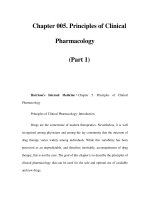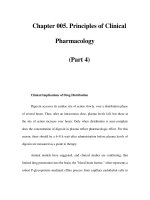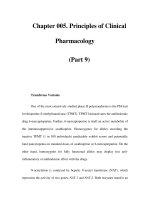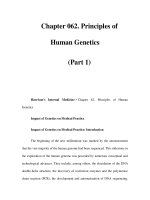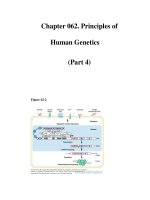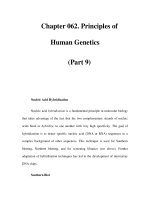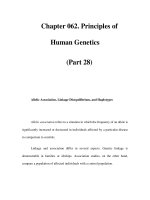ABC OF CLINICAL GENETICS - PART 9 pps
Bạn đang xem bản rút gọn của tài liệu. Xem và tải ngay bản đầy đủ của tài liệu tại đây (255.19 KB, 13 trang )
FRAX–A analysis. This method can also be modified to
determine the methylation status of the gene (the main
influence on normal FMR-1 gene expression). In prenatal
diagnosis, methylation analysis is problematic owing to the
presence of fetal methylation patterns, and the size of the
repeat becomes the most reliable predictive indicator.
Huntington disease (HD)
HD is a progressive fatal neurodegenerative disease. Like
FRAX–A, HD is caused by a triplet repeat expansion. The HD
expansion involves a CAG triplet in exon 1 of the IT15 gene on
chromosome 4. The expansion is translated into a
polyglutamine tract in the huntingtin protein gene product
that is believed to cause a dominant gain of function leading to
neuronal loss.
In normal individuals, the CAG unit in exon 1 has between
9 and 35 repeats. Affected individuals have repeats of 36 units
or greater, with over 90% of affected subjects having 40–55
repeats. In general, the greater the number of repeats an
individual has, the earlier the age of onset will be, although this
relationship is stronger for higher repeat numbers.
Since the CAG repeat expansion is the sole mutation
responsible for all HD cases, molecular genetic analysis
concentrates on this single region. Small CAG expansions can
be detected using PCR amplification of the repeat region.
The PCR products are then sized using polyacrylamide gel
electrophoresis. Samples with known repeat sizes may be used
as controls to determine the size of the expansion. Larger
expansions cannot be detected by PCR and the time-consuming
Southern blotting method must be used in cases where two
normal sized repeat alleles are not detected by PCR.
Charcot–Marie–Tooth disease (CMT)
CMT disease (or hereditary motor and sensory neuropathy,
HMSN) is clinically and genetically heterogeneous, but is
generally characterised by wasting and weakness of the distal
limb muscles with or without distal sensory loss. CMT may be
inherited in an autosomal dominant, autosomal recessive or
X linked manner. Clinically, the condition is divided into the
demyelinating CMT1 (with reduced nerve conduction
velocities) and axonal CMT2 (with nerve conduction velocites
largely preserved). Rarer clinical forms exist, including the
severe Dejerine–Sottas syndrome and hereditary neuropathy
with increased reflexes. The related condition HNPP
(hereditary neuropathy with liability to pressure palsies) creates
a milder phenotype characterised by recurrent, usually
transient sensorimotor neuropathies.
Many of the genes involved in CMT have now been cloned
and sequenced, allowing a genetic classification to be made
depending on the mutation or gene locus identified. Mutations
in over five genes have been reported in CMT, including
PMP22 (peripheral myelin protein on chromosome 17),
MPZ (myelin protein zero on chromosome 1), Connexin-32
(X chromosome), EGR2 and NEFL. The commonest mutational
event is the duplication of the entire PMP22 gene resulting in
clinical CMT type 1a. A deletion of the same gene gives rise to
the milder HNPP phenotype. Phenotypes of varying severity
can also be produced by point mutations (often base
substitutions) in any of the five genes mentioned above.
Prediction of disease severity in presymptomatic patients is
difficult as there is varying severity even within families.
Detection of the duplication or deletion of the PMP22 gene
is achieved using fluorescent dosage PCR analysis to determine
ABC of Clinical Genetics
96
Figure 18.7 PCR analysis of the trinucleotide repeat region associated
with Huntington disease. Note that a number of the samples have repeat
expansions within the pathological range as indicated by the arrows
(courtesy of Alan Dodge, Regional Genetic Service, St. Mary’s Hospital,
Manchester)
CAG repeat
number
Normal
range
69
53
40
34
25
19
13
8
Figure 18.8 Detection of the 17p11.2 duplication associated with
CMT/HMSN type 1a by fluorescent dosage analysis using flanking
microsatellite markers
Panel 1: Duplication-negative sample with approximately equal
contributions from each allele.
Panel 2: Duplication-positive sample with a 2:1 ratio of alleles
(courtesy of Dr David Gokhale, Regional Genetic Service. St. Mary’s
Hospital, Manchester)
1
2
acg-18 11/20/01 7:57 PM Page 96
the number of gene copies present. Following initial PCR
amplification with fluorescently-labelled primers, the products
are analysed by automated laser-induced fluorescence. Point
mutations in all five CMT genes are detected by a variety of
methods depending on local practices, including SSCP, DGGE
and DNA sequencing. Requests for prenatal testing in the UK
are rare.
Spinal muscular atrophy (SMA)
SMA encompasses a clinically and genetically heterogeneous
group of disorders characterised by degeneration and loss of
the anterior horn cells in the spinal cord and sometimes in the
brainstem nuclei, resulting in muscle weakness and atrophy.
Most cases are inherited in an autosomal recessive fashion,
although some affected families show dominant inheritance.
Childhood onset SMA is the second most common, lethal
autosomal recessive disorder in white populations, with an
overall incidence of 1 in 10 000 live births and a carrier
frequency of approximately 1 in 50. It is estimated to be the
second most frequent disease seen in paediatric neuromuscular
clinics after Duchenne muscular dystrophy.
Childhood onset SMA can be classified into three types,
distinguished on the basis of clinical severity and age of onset.
In type I (Werdnig–Hoffman disease), onset occurs within the
first six months of life and children usually die within two years.
In type II (intermediate type Dubowitz disease) onset is before
18 months with death occuring after two years. In type III
(Kugelberg–Welander disease), the disease has a later onset
and milder, chronic cause with affected children achieving
ambulation.
At least three genes have been reported to be associated
with the SMA type I phenotype on chromosome 5, namely
SMN, NAIP and p44. Diagnostic analysis in SMA patients is
restricted largely to analysis of the SMN gene. The SMN gene is
present in two copies, one centromeric (SMNC) and one
telomeric (SMNT). The absence of exons 7 and 8 in both
copies of the SMNT gene is a very reliable diagnostic test for
the majority of patients, confirming the clinical diagnosis of
SMA. Point mutations have been detected in affected
individuals who do not have homozygous deletions. The
PCR-based assay used for determining the presence or absence
of the SMNT gene is not able to detect individuals who are
heterozygous deletion carriers, and a gene dosage method of
analysis has been developed to improve carrier detection.
Duchenne and Becker muscular
dystrophies
Duchenne muscular dystrophy (DMD) and the milder Becker
form (BMD) are X linked recessive disorders causing
progressive proximal muscle weakness, associated with elevation
of serum creatine kinase levels. Weakness of the diaphragm and
intercostal muscles leads to respiratory insufficiency, and
involvement of the myocardium causing dilated
cardiomyopathy is common.
Both DMD and BMD result from mutations in the gene
encoding dystrophin, located at Xp21. The gene is one of the
largest identified covering approximately 2.5 megabases of
DNA and having 79 exons. Two-thirds of cases are caused by
deletion of one or more of the dystrophin exons that cluster in
two hot-spots within the gene. Large duplications account for a
further 5–10% of cases. The remainder of cases are due to a
variety of point mutations.
Molecular analysis of mendelian disorders
97
Figure 18.9 Detection of exon 7 and 8 deletions in the SMN1 gene
associated with spinal muscular atrophy can be detected using SSCP
analysis. Samples with deletions are indicated by the arrows (courtesy of
Dr Andrew Wallace, Regional Genetic Service, St. Mary’s Hospital,
Manchester)
SMN
exon 7
SMN
exon 8
Figure 18.10 The region of chromosome 5 involved in spinal muscular
atrophy includes duplications, repetitive regions, truncated genes and
pseudogenes making molecular analysis difficult. The suggested genomic
organisation of the SMA critical region is shown: p44 ϭSubunit of the
basal transcription factor TFIIH; NAIP ϭNeuronal apoptosis inhibitory
protein gene (⌿ϭpseudogene); SMNϭ Survival motor neurone gene.
Redrawn from Biros & Forest, J Med Genet 36, 1–8(1999)
Centromeric copy
p44
c
p44SMN
c
SMN
T
NAIPNAIP
Telomeric copy
Figure 18.11 Deletion analysis of the dsytrophin gene by multiplex PCR.
This analysis simultaneously amplifies exons 43, 45, 47, 48, 50, 51, 52, 53,
& 60 with deletions causing loss of bands (arrowed)
(courtesy of Dr Simon Ramsden, Regional Genetic Service, St. Mary’s
Hospital, Manchester)
acg-18 11/20/01 7:58 PM Page 97
Since just about all types of mutations can be seen in
DMD/BMD cases, a variety of techniques need to be used to
carry out a comprehensive molecular analysis. A multiplex PCR
approach in which a number of segments of the gene are
amplified simultaneously has been developed to rapidly detect
deletion of exons in males. Fluorescent dosage analysis can be
used to detect deletions and duplications in both affected males
and female carriers and chromosomal analysis using fluorescence
in situ hybridisation (FISH) techniques will also detect deletions
in female carriers. Detecting point mutations is possible with a
variety of methods including SSCP analysis, DGGE analysis, and
DNA sequencing but is not routine because of the very large
number of exons in the gene. In cases where the underlying
mutation is unknown, carrier detection and prenatal diagnosis
may still be accomplished by linkage analysis with a combination
of intragenic DNA markers and markers flanking the gene.
Familial breast cancer
Breast cancer is the commonest cancer seen in young women
from developed countries, affecting about 20% of all women
who die of cancer. Although the majority of breast cancer cases
are sporadic, approximately 5% have an inherited component.
The two susceptibility genes identified so far are BRCA1 and
BRCA2. The BRCA1 gene on chromosome 17q21 is involved in
45–50% of inherited breast-only cancer and 75–80% of
inherited breast/ovarian cancer. The BRCA2 gene on
chromosome 13q12-13 is involved in approximately 35% of
inherited breast-only cancer and 20% of breast/ovarian cancer.
In addition, BRCA2 is involved in a significant proportion of
male breast cancer.
Both BRCA1 and BRCA2 genes are large, containing 24 and
26 exons respectively. Since being isolated, a considerable
number of mutations have been described in both genes – over
250 in BRCA1 and over 100 in BRCA2. Up to 90% of these
mutations are predicted to produce a truncated protein. This
makes it possible to screen for mutations in the large central
exon 11 using the protein truncation test. The remaining exons
are generally screened one-by-one using methods such as
SSCP/heteroduplex analysis or DNA sequencing.
Population-specific founder mutations have been found in
eastern European, Ashkenazi Jewish and Icelandic
populations. Screening for the common mutation is therefore
undertaken as the first step in investigating families from
these population groups.
ABC of Clinical Genetics
98
Figure 18.12 Flourescence in situ hybridisation in a female carrier of a
Duchenne muscular dystrophy mutation involving deletion of exon 47.
Hybridisation with a probe from the centromeric region of the
X chromosome identifies both chromosomes. Only one X chromosome
shows a flourescent hybridisation signal with a probe corresponding to
exon 47, which indicates that the other X chromosome is deleted for
this part of the gene (courtesy of Dr Lorraine Gaunt, Regional Genetic
Service, St. Mary’s Hospital, Manchester)
Figure 18.13 Detection of mutations in the BRCA1 gene that cause
premature termination of translation using the protein truncation test.
The truncated protein products are shown by the arrows
(courtesy of Dr Julie Wu, Regional Genetic Service St Mary’s Hospital,
Manchester)
acg-18 11/20/01 7:58 PM Page 98
The prevention of inherited disease by means of genetic and
reproductive counselling and prenatal diagnosis is often
emphasised. Genetic disorders may, however, be amenable to
treatment, either symptomatic or potentially curative.
Treatment may range from conventional drug or dietary
management and surgery to the future possibility of gene
therapy. The level at which therapeutic intervention can be
applied is influenced by the state of knowledge about the
primary genetic defect, its effect, its interaction with
environmental factors, and the way in which these may be
modified.
Conventional treatment
Increasing knowledge of the molecular and biochemical basis
of genetic disorders will lead to better prospects for therapeutic
intervention and even the possibility of prenatal treatment in
some disorders. In the future, treatment of common
multifactorial disorders may be improved if genotype analysis of
affected individuals identifies those who are likely to respond to
particular drugs. In most single gene disorders, the primary
defect is not yet amenable to specific treatment. Conventional
treatment aimed at relieving the symptoms and preventing
complications remains important and may require a
multidisciplinary approach. Management of Duchenne
muscular dystrophy, for example, includes neurological and
orthopaedic assessment and treatment, physiotherapy,
treatment of chest infections and heart failure, mobility aids,
home modifications, appropriate schooling, and support for
the family, all of which aim to lessen the burden of the
disorder. Lay organisations often provide additional support for
the patients and their families. The Muscular Dystrophy
Organisation, for example, provides information leaflets,
supports research, and employs family care officers who work
closely with families and the medical services.
Environmental modification
The effects of some genetic disorders may be minimised by
avoiding or reducing exposure to adverse environmental
factors. These environmental effects are well recognised in
common disorders such as coronary heart disease, and
individuals known to be at increased genetic risk should be
encouraged to make appropriate lifestyle changes. Single gene
disorders may also be influenced by exposure to environmental
triggers. Attacks of acute intermittent porphyria can be
precipitated by drugs such as anticonvulsants, oestrogens,
barbiturates and sulphonamides, and these should be avoided
in affected individuals. Attacks of porphyria cutanea tarda are
precipitated by oestrogens and alcohol. In individuals with
glucose-6-phosphate dehydrogenase deficiency, drugs such as
primaquine and dapsone, as well as ingesting fava beans, cause
haemolysis.
Exposure to anaesthetic agents may be hazardous in some
genetic disorders. Myotonic dystrophy is associated with
increased anaesthetic risk and suxamethonium must not be
given to people with pseudocholinesterase deficiency.
Malignant hyperthermia (MH) is an autosomal dominant
condition in which individuals with MH susceptibility, who are
otherwise healthy, may develop life-threatening hyperpyrexial
99
19 Treatment of genetic disorders
Gene
Gene product
Metabolic
effect
Functional
effect
Structural
effect
Figure 19.1 Mechanisms of gene action
Figure 19.2 Letter written by boy aged 11 with Duchenne muscular
dystrophy
Figure 19.3 Ankle splint used in Duchenne muscular dystrophy (courtesy
of Jenny Baker, Clinical Nurse Specialist, Royal Manchester Children’s
Hospital)
Figure 19.4 Porphyria cutanea tarda (courtesy of Dr Timothy Kingston,
Department of Dermatology, Macclesfield General Hospital)
acg-19 11/20/01 8:01 PM Page 99
reactions when exposed to a variety of inhalational anaesthetics
and muscle relaxants. Relatives with MH susceptibility can be
identified by muscle biopsy and in vitro muscle contracture
testing. This enables them to ensure that they are not exposed
to the triggering agents in any future anaesthetic. It is
recommended that susceptible individuals wear a MedicAlert or
similar medical talisman containing written information at all
times.
Exposure to sunlight precipitates skin fragility and blistering
in all the porphyrias except the acute intermittent form.
Sunlight should also be avoided in xeroderma pigmentosum (a
rare defect of DNA repair) and in oculocutaneous albinism
because of the increased risk of skin cancer.
Surgical management
Surgery plays an important role in various genetic disorders.
Many primary congenital malformations are amenable to
successful surgical correction. The presence of structural
abnormalities is often identified by prenatal ultrasound
scanning, and this allows arrangements to be made for delivery
to take place in a unit with the necessary neonatal surgical
facilities when this is likely to be required. In a few instances,
birth defects such as posterior urethral valves, may be amenable
to prenatal surgical intervention. In some disorders surgery
may be required for abnormalities that are secondary to an
underlying metabolic disorder. In girls with congenital adrenal
hyperplasia, virilisation of the external genitalia is secondary to
excess production of androgenic steroids in utero and requires
reconstructive surgery. In other disorders, structural
complications may occur later, such as the aortic dilatation that
may develop in Marfan syndrome. Surgery may also be needed
in genetic disorders that predispose to neoplasia, such as the
multiple endocrine neoplasia syndromes, where screening
family members at risk permits early intervention and improves
prognosis. Some women who carry mutations in the BRCA1 or
BRCA2 breast cancer genes elect to undergo prophylactic
mastectomy because of their high risk of developing breast
cancer.
Metabolic manipulation
Some inborn errors of metabolism due to enzyme deficiencies
can be treated effectively. Although direct replacement of the
missing enzyme is not generally possible, enzyme activity can
be enhanced in some disorders. For example, phenobarbitone
induces hepatic glucuronyl transferase activity and may lower
circulating concentrations of unconjugated bilirubin in the
Crigler–Najjar syndrome type 2. Vitamins act as cofactors in
certain enzymatic reactions and can be effective if given in doses
above the usual physiological requirements. For example,
homocystinuria may respond to treatment with vitamin B
6
,
certain types of methylmalonic aciduria to vitamin B
12
, and
multiple carboxylase deficiency to biotin. It may also be possible
to stimulate alternate metabolic pathways. For example,
thiamine may permit a switch to pyruvate metabolism by means
of pyruvate dehydrogenase in pyruvate carboxylase deficiency.
The clinical features of an inborn error of metabolism may
be due to accumulation of a substrate that cannot be
metabolised. The classical example is phenylketonuria, in
which the absence of phenylalanine hydroxylase results in high
concentrations of phenylalanine, causing mental retardation,
seizures and eczema. The treatment consists of limiting dietary
intake of phenylalanine to that essential for normal growth.
Galactosaemia is similarly treated by a galactose free diet. In
ABC of Clinical Genetics
100
Methionine
Homocysteine
Serine
Homocystine
Cystathionine -synthase
Vitamin B
6
Cystathionine
Homoserine
Cysteine Cystine
Figure 19.7 Pathway for homocysteine metabolism: most cases of
homocystinuria are due to deficiency of cystathionine beta-synthase, which
requires vitamin B
6
cofactor
Figure 19.6 Virilisation of female genitalia in congenital adrenal
hyperplasia (21 hydroxylase deficiency) (courtesy of Professor Dian
Donnai, Regional Genetic Service, St. Mary’s Hospital, Manchester)
M
E
D
I
C
A
L
E
R
T
M
E
D
I
C
A
L
E
R
T
Figure 19.5 The MedicAlert emblem appearing on bracelets and
necklaces. The MedicAlert foundation registered charity website address is
acg-19 11/20/01 8:01 PM Page 100
other disorders the harmful substrate may have to be removed
by alternative means, such as the chelation of copper with
penicillamine in Wilson disease and peritoneal dialysis or
haemodialysis in certain disorders of organic acid metabolism.
In hyperuricaemia, urate excretion may be enhanced by
probenecid or its production inhibited by allopurinol, an
inhibitor of xanthine oxidase.
In another group of inborn errors of the metabolism the
signs and symptoms are due to deficiency of the end product of
a metabolic reaction, and treatment depends on replacing this
end product. Defects occurring at different stages in
biosynthesis of adrenocortical steroids in the various forms of
congenital adrenal hyperplasia are treated by replacing cortisol,
alone or together with aldosterone in the salt losing form.
Congenital hypothyroidism can similarly be treated with
thyroxine replacement. In some disorders, such as
oculocutaneous albinism in which a deficiency in melanin
production occurs, replacing the end product of the metabolic
pathway is, however, not possible.
Gene product replacement
Gene product replacement therapy is an effective strategy when
the deficient gene product is a circulatory peptide or protein.
This forms the standard treatment for insulin dependent
diabetes mellitus, haemophilia and growth hormone
deficiency – conditions that can be treated with systemic
injections. This approach is more difficult when the gene
product is needed for metabolism within specific tissues such as
the central nervous system, where the blood–brain barrier
presents an obstacle to systemic replacement.
Genetically engineered gene products are available for
clinical use. Recombinant human insulin first became available
in 1982. The production of human gene products by
recombinant DNA techniques ensures that adequate supplies
are available for clinical use and produces products that may be
less immunogenic than those extracted from animals. In some
cases transgenic animals have been created that produce
human gene products as an alternative to cloning in microbial
systems.
A potential problem associated with gene product
replacement is the initiation of an immunological reaction to
the administered protein by the recipient. In haemophilia, the
effectiveness of factor VIII injections is greatly reduced in the
10–20% of patients who develop factor VIII antibodies. The
efficiency of replacement therapy is, however, demonstrated by
the increase in documented life expectancy for haemophiliacs
from 11 years in the early 1900s to 60–70 years in 1980. The
reduction in life expectancy to 49 years between 1981 and 1990
reflects the transmission of the AIDS virus in blood products
during that time period, when 90% of patients requiring
repeated treatment became HIV positive. Factor VIII extracts
are now highly purified and considered to be free of viral
hazard, and recombinant factor VIII has been available
since 1994.
An alternative method of replacement is that of organ or
cellular transplantation, which aims at providing a permanent
functioning source of the missing gene product. This approach
has been applied to some inborn errors of metabolism, such as
mucopolysaccharidoses, using bone marrow transplantation
from matched donors. Again, the blood–brain barrier prevents
effective treatment of CNS manifestations of disease. The
potential for direct replacement of missing intracellular
enzymes in treating inborn errors of metabolism is also being
determined experimentally.
Treatment of genetic disorders
101
Figure 19.8 Products low in phenylalanine are needed for dietary
management of phenylketonuria
Figure 19.9 Some of the first insulins with human sequence to be
prepared biosynthetically or by enzymatic modification of porcine material
Table 19.1 Examples of gene products produced by
recombinant techniques for therapeutic use
Product Disease treated
Alpha interferon Hairy cell leukaemia
Beta interferon Multiple sclerosis
Gamma interferon Chronic granulomatous disease
Factor VIII Haemophilia A
Factor IX Haemophilia B
Insulin Diabetes
Growth hormone Growth hormone deficiency
Erythropoeitin Anaemia
DNase Cystic fibrosis
Box 19.1 Source of cells for replacement therapy
• autotransplantation: use of cells from individual being
treated
• allotransplantation: use of cells from another individual
• xenotransplantation: use of animal cells
acg-19 11/20/01 8:01 PM Page 101
Gene therapy
The identification of mutations underlying human diseases has
led to a better understanding of the pathogenesis of these
disorders and an expectation that genetic modification may
play a significant role in future treatment strategies. No such
treatments are currently available, but many gene therapy trials
are underway.
The first clinical trials in humans were initiated in 1990 and
since then over 150 have been approved. Most of these have
involved genetic manipulation in the therapy of cancer, some
have involved infectious diseases or immune system disorders
and a few have involved inherited disorders, notably cystic
fibrosis. Human trials are all aimed at altering the genetic
material and function of somatic cells. Although gene therapy
involving germline cells has been successful in animal studies
(for example curing thalassaemia in mice) manipulation of
human germline cells is not sanctioned because of ethical and
safety concerns. So far, results of human gene therapy trials
have been disappointing in terms of any long-term therapeutic
benefit and many technical obstacles remain to be overcome.
The classical gene therapy approach is to introduce a
functioning gene into cells in order to produce a protein
product that is missing or defective, or to supply a gene that
has a novel function. This type of gene augmentation approach
could be appropriate for conditions that are due to deficiency
of a particular gene product where the disease process may be
reversed without very high levels of gene expression being
required. Autosomal recessive and X linked recessive disorders
are likely to be the best candidates for this approach since most
are due to loss of function mutations leading to deficient or
defective gene products. Augmentation gene therapy is not
likely to be successful in autosomal dominant disorders, since
affected heterozygotes already produce 50% levels of normal
gene product from their normal allele. In these cases, gene
therapy is not likely to restore gene product production to
levels that will have a therapeutic effect. In neoplastic disorders
the classical gene therapy approach aims to introduce genes
whose products help to kill malignant cells. The genes
introduced may produce products that are toxic, act as
prodrugs to aid killing of cells by conventionally administered
cytotoxic agents, or provoke immune responses against the
neoplastic cells.
Genetic manipulation can take place ex vivo or in vivo. In
ex vivo experiments and trials, cells are removed and cultured
before being manipulated and replaced. This approach is
feasible for therapies involving cells such as haemopoetic cells
and skin cells that can be easily cultured and transplanted. In
in vivo methods, the modifying agents are introduced directly
into the individual.
To be effective, augmentation gene therapy requires
methods that ensure the safe, efficient and stable introduction
of genes into human cells. The production of adequate
amounts of gene products in appropriate cells and tissues is
needed with appropriate control of gene expression and
reliable methods of monitoring therapeutic effects. Before
application of gene therapy to humans, in vitro studies are
needed together with proof of efficiency and safety in animal
models. The possibility of insertional mutagenesis and the
dangers of expressing genes in inappropriate tissues need to be
considered. There may also be immunological reactions
mounted against viral vector material or the gene product itself
if this represents a protein that is novel to the individual being
treated.
Classical gene augmentation therapy is not suitable for
disorders that are due to the production of an abnormal
ABC of Clinical Genetics
102
Select for
cells expressing
inserted gene
Cultured stem cells
containing inserted gene
Inject
recombinant
cells back into
patient
Remove bone
marrow
cells
Isolate and culture
stem cells
Gene transfer
Incorporate required gene
into viral vector
Figure 19.11 Diagram of augmentation gene therapy approach
Disease phenotype
Phenotype correction
Cytotoxic agent
Host response
Introduction of normally
functioning gene
Introduction of prodrug gene
Introduction of toxic gene
Introduction of antigen or cytokine gene
Figure 19.10 Illustrations of gene therapy approaches shown in table 19.2
Table 19.2 Potential application of classical gene therapy
approaches
Introduction of normally Correction of phenotype
functioning gene due to absence of gene
product
Introduction of toxic gene Direct cell death in
neoplastic or infective
diseases
Introduction of prodrug Enhanced cell killing by
gene cytotoxic drugs in
neoplastic or infective
diseases
Introduction of antigen or Stimulation of immune
cytokine gene response to kill cells in
neoplastic or infective
diseases
acg-19 11/20/01 8:01 PM Page 102
protein that has a harmful effect because of its altered
function. This applies to autosomal dominant disorders where
the mutation has a dominant negative effect, producing a
protein with a new and detrimental function, as in Huntington
disease. Genetic manipulation in this type of disorder requires
targeted correction of the gene mutation or the inhibition of
production of the abnormal protein product. Several
methodologies involving DNA or RNA modification are
currently being investigated.
Other approaches to gene therapy include the increased
expression of protein isoforms not normally expressed in the
affected tissue, or the upregulation of other interacting genes
whose products may ameliorate the disease process. In
Duchenne muscular dystrophy, for example, it is possible that
upregulation of a protein called utrophin, that is related to
dystrophin, may have some beneficial effect in slowing the
progression of muscle damage.
Treatment of genetic disorders
103
DNA helix
Inhibition of
gene transcription
Targeted
mutation
correction
Targeted
mRNA
repair
CORRECTION
Mutation
Inhibition of
mRNA translation
or
destruction of mRNA
Inhibition of
action of
protein product
DNA
mRNA
Protein
INHIBITION
Figure 19.12 New strategies for gene therapy
acg-19 11/20/01 8:01 PM Page 103
104
Although many areas of medical science now rely heavily on the
internet, human genetics in particular has benefited from its
unique ability to provide ready access to information. This is
because of the huge quantity of new information that has been
generated recently by the Human Genome Project and
numerous other research programmes. It is important to
remember that not all the information available on the internet
is reliable. Anyone with a computer and modem can have their
own website and can interpret and disseminate original
information in a highly subjective manner. For this reason it is
important to use online information that comes from a
bonafide source, preferably referenced to original
peer-reviewed material. The following section attempts to
provide a short guide to websites that may be of relevance to
clinical genetics and associated specialties.
Search engines
One of the first problems facing the new internet user is
knowing where to start. There are some subject directories
providing an overall index rather like a “yellow pages”, but
most users rely on websites, referred to search engines, that
search the internet for them. Not surpringly, there are a large
number of search engines, although each internet service
provider will have its preferred website for searching that
provides an easy starting point. Website addresses (URLs:
uniform resource locators) for a few well-known search engines
sites are given below (all are preceded by http://):
• AltaVista
tm
www.altavista.co.uk
• Lycos
tm
www.lycos.co.uk
tm
www.google.com
• Yahoo
tm
uk.search.yahoo.com
• GoTo
tm
www.goto.com
• Cyber411
tm
www.c4.com (a useful search of search engines)
Human genetics
A useful starting point for general information about human
genetics can be found at the British Society for Human
Genetics (BSHG) website (www.bshg.org.uk). Along with
general information about human genetics and a directory of
UK human genetics centres, the BSHG website has links to all
major websites involving human genetics. These links include
those to the BSHG constituent societies (Clinical Genetics
Society, Association of Clinical Cytogeneticists, Clinical
Molecular Genetics Society and Association of Genetic Nurses
and Counsellors). There are also links to a number of other
sites providing useful educational resources, such as online
tutorials on genetics.
Finding published literature
The United States National Centre for Biotechnology
Information (NCBI) provides a range of invaluable
online resources for all types of information on genes
and genetics (www.ncbi.nlm.nih.gov/Pubmed). The site
provides free access to the PubMed database, which can be
rapidly searched for published articles on all aspects of
medical research.
Inherited disease databases
The OMIM database (Online Mendelian Inheritance in Man) is
a well-established database containing over 11 000 entries on
inherited conditions and disease phenotypes. The strength of
the site is that entries on each condition rely on peer-reviewed
data and are comprehensively referenced, making the
information highly reliable. Entries are linked to the PubMed
database and to additional resources such as DNA sequence
and mapping information. Omim can be accessed through the
NCBI website (www.ncbi.nlm.nih.gov/omim) or the UK
Human Genome Mapping Project Resource Centre
(www.hgmp.mrc.ac.uk/omim).
Information on specific genes
GeneCards (bighost.area.ba.cnr.it/GeneCards or
bioinformatics.weizmann. ac.il/cards) is a database of human
genes, their products and their involvement in disease. It offers
concise information about the functions of all human genes
that have an approved symbol, and some others. The human
map database can be searched by cytogenetic location, gene or
marker name, accession number or the disease name. As with
the NCBI databases, the information viewed is now linked to
other sites to provide a highly integrated data system known as
UDB (Unified Database for human genome mapping).
Mutation databases
The Human Gene Mutation Database (HGMD) is a UK site
that provides a rapid method of searching for mutations found
in human disease genes and can be accessed using the URL:
archive.uwcm.ac.uk/uwcm/mg/hgmd0.html. Entries on each
gene are referenced with links provided to the PubMed
database. The site also has links to specific gene mutation
databases.
Mapping and marker databases
The UK Human Genome Mapping Project (HGMP) funded by
the Medical Research Council provides both biological and
data resources to the medical research community, with a
special emphasis on areas relevant to the Human Genome
programme. The Bioinformatics division gives registered users
access to a large range of databases and computer programs to
aid genomic and proteomic research. The site can be accessed
using the URL: www.hgmp.mrc.ac.uk. The number of databases
available is huge, and includes analysis services such as BLAST
(which searches for sequence similarity between genes), DNA
and protein sequences databases, chromosome specific
mapping data and databases of genetic markers (e.g. for
linkage studies). Other sites providing similar information and
links to external sites are the US Human Genome Mapping
Project (www.ornl.gov/hgmis) and the European
Bioinformatics Institute (www.ebi.ac.uk).
Information on laboratory services and research groups
Locating a UK laboratory that is able to carry out analysis of
specific genes can be achieved using the Clinical Molecular
Genetics Society website (www.cmgs.org). The site also has links
to molecular genetics laboratories throughout the UK. Services
offered by molecular genetic laboratories in mainland Europe
can be searched using the EDDNAL (European Directory of
DNA Laboratories) using the URL: www.eddnal.com
GeneTests
tm
(www.genetests.org) provides information on
genetics clinics, genetic counselling services and genetic testing
laboratories in the USA and in other countries. Information is
free, although registration is required to use the information.
The related site GeneClinics
tm
(www.geneclinics.org) provides
information on specific inherited disorders and the role of
20 The internet and human genetics
acg-20 11/20/01 8:03 PM Page 104
genetic testing in the diagnosis, management and genetic
counselling of patients with inherited conditions.
Patient organisations
Lay support groups have been established for many genetic
conditions. These provide information on specific diseases
including research updates and the opportunity for contact
between individual families. The larger support groups also
organise conferences for families and professionals as well as
funding research. In the UK, individual support groups can be
contacted through Contact a Family (www.cafamily.org.uk).
The Genetic Interest Group (www.gig.org.uk) is an alliance of
support groups presenting a unified voice for families in the
public arena. Similar groups in the US are the Genetic Alliance
(www.geneticalliance.org) and the National Organisation for
Rare Disorders (NORD) (www.rarediseases.org).
The internet and human genetics
105
acg-20 11/20/01 8:03 PM Page 105
106
General educational resources
MendelWeb (general genetics information)
/>DNA from the beginning (introductory genetics tutorials)
/>GeneClinics (review articles on several genetic conditions)
Specialised information resources
and databases
National Center for Biotechnology Information
(based at NIH, USA)
On-Line Mendelian Inheritance in Man
or
/>UK Human Genome Mapping Project (HGMP)
Resource Centre
US Human Genome Organisation (HUGO)
Project Information
/>HUGO Gene Nomenclature Committee (HGNC)
/>Research Program on Ethical, Legal and Social Implications of
Human Genome Project
/>GeneCards (detailed information about individual
human genes)
or
/>Human Genome Mutation Database (HGMD)
/>European Bioinformatics Institute
Familial Cancer Database
Genetic societies
British Society for Human Genetics
Constituent societies
Clinical Genetics Society
/>Association of Genetic Nurses and Counsellors
Association of Clinical Cytogeneticists
Clinical Molecular Genetics Society
Society for the Study of Inborn Errors of Metabolism
Genetical Society
Irish Society for Human Genetics
/>European Society of Human Genetics
American Society of Human Genetics
/>Human Genetics Society of Australasia
American Society of Gene Therapy
International Federation of Human Genetics Societies
/>UK organisations and committees
Department of Health (Genetics Section)
/>Human Genetics Commission
Human Genetics Advisory Commission (now subsumed into
the Human Genetics Commission)
/>Advisory Committee on Genetic Testing (now subsumed into
the Human Genetics Commission)
/>Gene Therapy Advisory Committee (GTAC)
/>Human Fertilisation and Embryology Authority
/>UK Public Health Genetics Network
/>Genetics and Insurance Committee (GAIC)
/>UK Forum for Genetics & Insurance
Genetics Interest Group
Information about molecular
genetic services
Clinical Molecular Genetics Society (lists UK labs offering
molecular tests)
Websites
acg-web 11/20/01 8:07 PM Page 106
Websites
107
GeneTests (US labs offering molecular tests)
Eddnal (European labs offering molecular tests)
Patient information and support
networks
Contact-a-Family (UK family support group alliance)
Unique. Rare chromosome disorder support group
Antenatal Results and Choices (ARC)
/>European Alliance of Genetic Support Groups (EAGS)
/>Genetic Alliance (US patient support group alliance)
National Organisation for Rare Disorders (NORD)(US)
acg-web 11/20/01 8:07 PM Page 107
108
Alleles Alternative forms of a gene or DNA
sequence occurring at the same
locus on homologous
chromosomes.
Allelic association The occurrence together of two
particular alleles at neighbouring
loci on the same chromosome
more commonly than would be
expected by chance.
Aneuploid Chromosome constitution with one
or more additional or missing
chromosomes compared to the
full set.
Anticipation Earlier onset or more severe
manifestation of a genetic
disorder in successive
generations of a family.
Anticodon Three-base sequence in tRNA that
pairs with the three-base codon
in mRNA.
Antisense strand DNA strand of a gene used as a
(template strand) template for RNA synthesis
during transcription.
Autosome Any chromosome other than the
sex chromosomes.
Autozygosity Homozygosity for alleles identical
by descent in the offspring of
consanguineous couples.
Bayesian analysis Mathematical method for
calculating probability of carrier
state in mendelian disorders by
combining several independent
likelihoods.
Candidate gene A gene identified as being a
possible cause of a genetic
disease when mutated.
Carrier A healthy person possessing a
mutant gene in heterozygous
form: also refers to a person
with a balanced chromosomal
translocation.
Centromere The portion of a chromosome
joining the two chromatids
between the short and long arms.
Chiasma Visible crossover between
homologous chromosomes
during prophase stage of
meiosis, resulting in exchange of
genetic material between the
chromosomes.
Chimaera Presence in a person of two
different cell lines derived from
fusion of two zygotes.
Chorionic villus Procedure for obtaining fetally
sampling (biopsy) derived chorionic villus material
for prenatal diagnosis.
Chromosome A structure within the nucleus
composed of double stranded
DNA bearing a linear array of
genes that condenses and
becomes visible at cell division.
Chromosome painting Fluorescence labelling of a whole
chromosome using multiple
probes from a single
chromosome.
Clone An identical copy of the DNA of
a cell or whole organism.
Coding DNA DNA that encodes a mature
messenger mRNA.
Codominant Trait resulting from expression of
both alleles at a particular locus
in heterozygotes for example,
the ABO blood group system.
Codon Sequence of three adjacent
nucleotides in mRNA (and by
extension in coding DNA) that
specifies an amino acid or
translation stop signal.
Complementary DNA Single stranded DNA synthesized
(cDNA) from messenger RNA that
contains only coding sequence.
Concordance Presence of the same trait in both
members of a pair of twins.
Congenital Present from birth.
Consanguinity Marriage or partnership between
two close relatives.
Consultand The person through whom a family
with a genetic disorder is referred
to genetic services.
Contiguous Syndrome caused by deletion of a
gene syndrome group of neighbouring genes,
some or all of which contribute
to the phenotype.
Cytogenetics The study of normal and abnormal
chromosomes.
Deletion Loss of genetic material
(chromosomal or DNA
sequence).
Diploid Normal state of human somatic cells
containing two haploid sets of
chromosomes (2n).
Discordance Presence of a trait in only one
member of a pair of twins.
Dizygotic twins Twins produced by the separate
fertilization of two different eggs.
DNA Deoxyribonucleic acid, the
molecule constituting genes.
DNA electrophoresis Separation of DNA restriction
fragments by electrophoresis in
agarose gel.
DNA fingerprinting Analysis that detects DNA pattern
unique to a given person.
DNA polymerase Enzyme concerned with synthesis of
double stranded DNA from single
stranded DNA.
Dominant Trait expressed in people who are
heterozygous for a particular
gene.
Duplication Additional copy of chromosomal
material or DNA sequence.
Dysmorphology Study of malformations arising from
abnormal embryogenesis.
Glossary
acg-gls 11/20/01 8:06 PM Page 108
